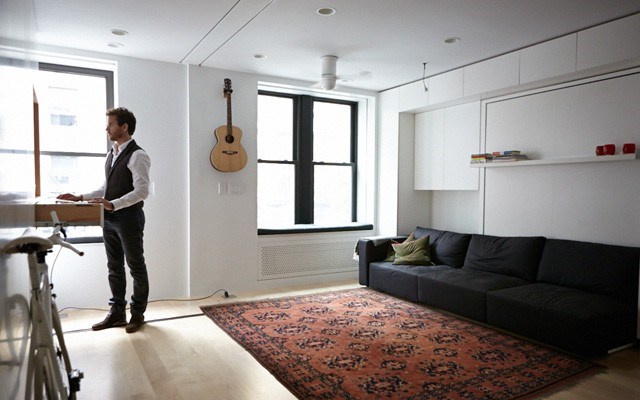Living well does not mean owning a Humvee and a 4,000-square-foot (370-square-metre) McMansion says Graham Hill, founder of lifestyle website LifeEdited.
According to Hill, the world's limited resources, squeezed by Western ostentatiousness, requires great change of us — and size may indeed matter.
In 2009, Hill — also the co-founder of pro-environment culture website Treehugger — purchased a 420-sq. ft. (39-sq.-m.) apartment in New York City in order to show that people could have all they need in life by using less, especially less space.
The apartment was gutted and redesigned by two Romanian architecture students following an international competition.
The result became Hill's home, codenamed LifeEdited, transformed into what The New York Times called, "The apartment of the future." He is now trying to convince developers and the construction industry to follow his example.
A long way away from his diminutive home, Hill came to Wanderlust Whistler last weekend to talk about the project.
"I've sold a couple of companies and made some money and could live in a really big house if I want to. I've done it and discovered that a simpler life is what I want. Life is about experiences and connection and not stuff," he says.
He says he is now trying to build a "literal treehugger" — to develop his own apartment building in New York along these less-is-more lines.
"An apartment building of the future that's very green, with lots of sharing, socially progressive and a great place to live," Hill says.
Hill sold his first company, a Seattle-based web developer, in 1998. In his own words, he started "living the American dream," and it felt wasteful and overly complex.
Now, due to his own experience about how people can function in smaller spaces by applying smarter concepts and technology — and changes in their behaviour, life-editing has become a passion and his work.
"The big idea is simply that North America has super-sized itself in the past 60 years or so, and more is not always better. I think we're discovering that," he says.
"If you look at housing, we've gone from the 1,000-sq.-ft. (93-sq.-m.) average home to 2,600 sq. ft. (241 sq. m.) while our families have shrunk. We have three times as much space per person as we did 60 years ago."
On top of this — and partly because of this — our energy and waste footprints are four times as big, he says.
"Plus, we have a lot more personal debt, happiness levels have flatlined — and despite having all this extra space, the U.S. has this $22-billion personal storage industry to store more of our junk," Hill says.
"We advocate a less-but-better lifestyle, to be much more conscious of what you bring into your life."
That the status quo is not working well is why he agreed to give his first-ever talk at the Wanderlust festival, he adds.
"I thought (attendees) would be receptive to the ideas. It seems like so much of Wanderlust is physical. I want to help people think about their lives and help them consider making changes now or in the future."
He has decided to squeeze his life further by transforming and moving into a new 107-sq.-m. apartment. His partner will share the space with him.
It helps that he has also taken steps to change his work life, too.
"It's great. I've designed my company virtually so I can live and work wherever," Hill says.
Wherever, in this case, means Maui, where he spends his winters. But there is no mansion there, either.
"I've lived in a tent, I've lived in a car port. I've also lived in a 200-sq.-ft. (18-sq.-m.) cabin — and I now am working on a 1,000-sq.-ft. (305-sq.-m.) home with a bunch of tiny houses as an eco compound," he says.
What has the experiment taught Hill?
"I learned we could live anywhere as I worked on the two companies I owned. It was a nice lifestyle and it was cemented for me," he says.
The world should be more like a living room than our actual living room.
This trend makes him hopeful.
"And I think the pendulum is swinging back. I think maybe we were fearful of intimacy, but we are a lot more social than we think we are. It's nice to have a private something-or-other, but people want to be around people. For years, we were building our own personal kingdoms; public and shared space shrank. Now it's heading in the opposite direction," Hill says.
He realizes many people still don't want to give up their possessions and props.
"I ask people to consider it. Everyone has their thing. I tend to own a lot of sports equipment because I like kite surfing, but most of us don't need 17 pairs of jeans — and as a core idea that expands to everything," he says.
"People say that you can't do that with kids, but of course you can... my partners in LifeEdited are living with their partners and kids in around 650 sq. ft (198 sq. m.) each."




